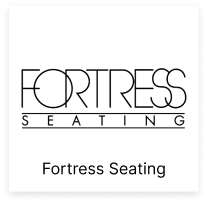
A Complete Guide to
Buying Theater
Seating Online
In a world of convenience and home delivery, it seems that anything can be purchased online. And when it comes to setting up your home theater, it is no different. When you are considering your entertainment layout, selecting the perfect seating for your movie nights is a crucial part of the final outcome.
And when it comes to purchasing your seating, why not do it from the comfort of your own home? Shopping online for home theater seating is simple and expedient when you keep some particular considerations and information in mind. This guide will walk you through the process of selecting the perfect seating for your home theater and assist your choice for the best possible cinematic experience outside of a movie theater.

Home Theater Space: How Many Chairs Will Fit?

One of the first considerations for selecting your new seating layout is the physical calculations of your home theater.
Factor to consider for what seating will
best fit your needs.
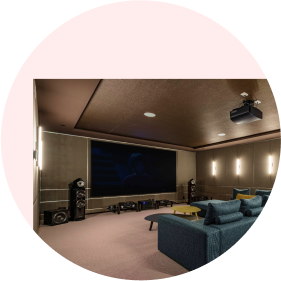
The size
of your home theater
space

The specifications
of the screen
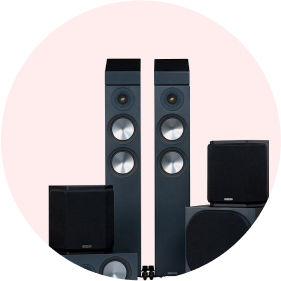
Sound System

Your ideal
audience size
To know how many chairs you will be purchasing, and to some extent the types of chairs that would work best for your environment, the physical constraints of your home theater room will greatly dictate your choice.
Seat Shopping by Size
Your first step will be to determine the size of your home theater space. It is important to keep screen size, speaker placement, and projector location in mind here.
While your home theater room itself may be a large size, all the elements of sound and projection systems do take up space and will narrow your measurement parameters when it comes to how much room you have for seating.
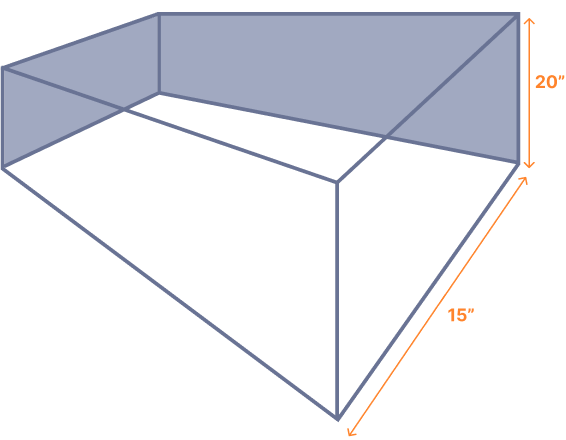
But as a general rule of thumb,
a home theater room that is at least 15 feet wide and 20 feet long is typically a good basis for an appropriate entertainment setup.
Width: 15 feet
Height: 20 feet
So, how big is your home theater? Once you accurately measure your space, it is time to consider your ideal audience size, do some calculations, and create a diagram of where you envision each piece of home theater seating to go. Let’s delve into this process a little deeper.
How Much Room Is Needed for
Seating in a Home Theater?
Unfortunately, there is no short answer here. You need to take the room itself, speaker placement and angles, aisle movement space, and proper screen viewing distance into consideration, as well as the possibility of vertical seating placement by using risers.
But luckily, there are some easy calculations that help you figure out some of these measurements and help narrow down your seating options.
Chair Width for Rows
How many seats can you fit into one row? How many seats can you fit into one row? This will solve the width aspect of home theater seating space, and help you calculate the number of seats your home theater can accommodate.
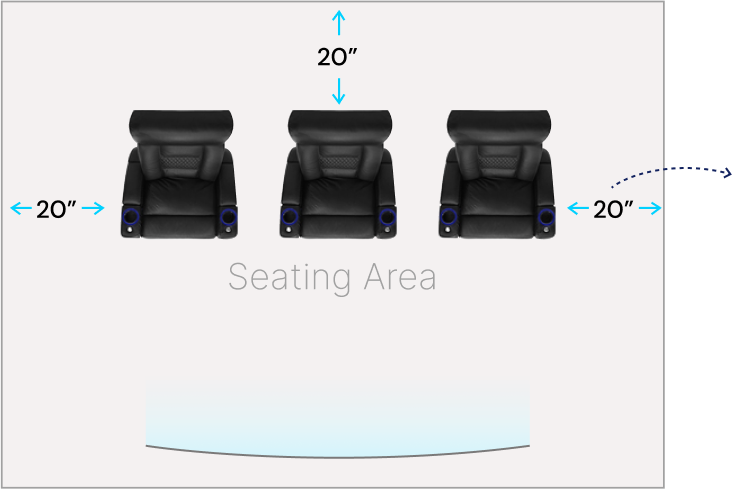
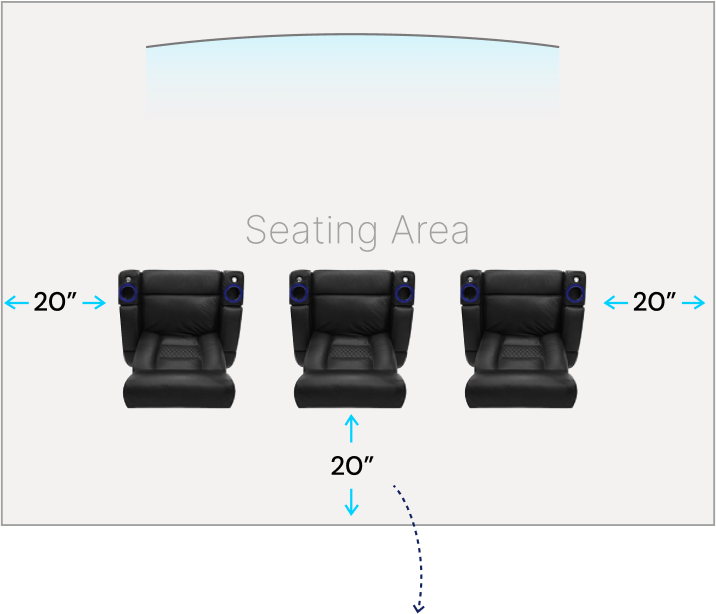
Aisle movement comes into play here,
as you want to give your audience at least 20 inches of space on either side of the row to come and go without incident or collision.
Keep in mind that home theater seats are measured from center to center—that is, from the center of one armrest to the center of the next.
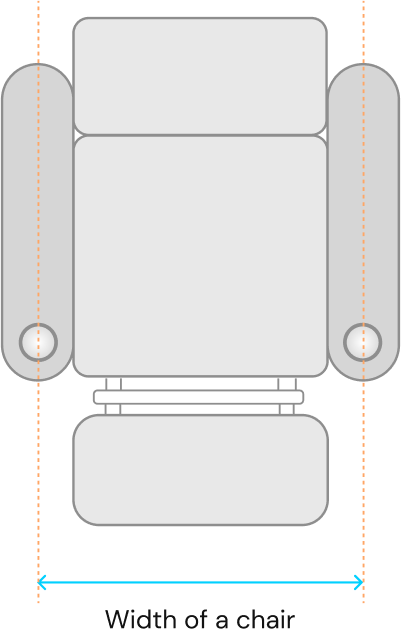
To solve for how many chairs will fit in one row, there are three aspects: the width of your home theater room, seat measurements, and those two aisles of 20 inches each. So, if your space is 132 inches wide, after subtracting the two 20-inch aisles you will discover that you actually have 92 inches of usable seating space.
home theater space
extra walking space
(20” + 20” = 40”)
effective seating space
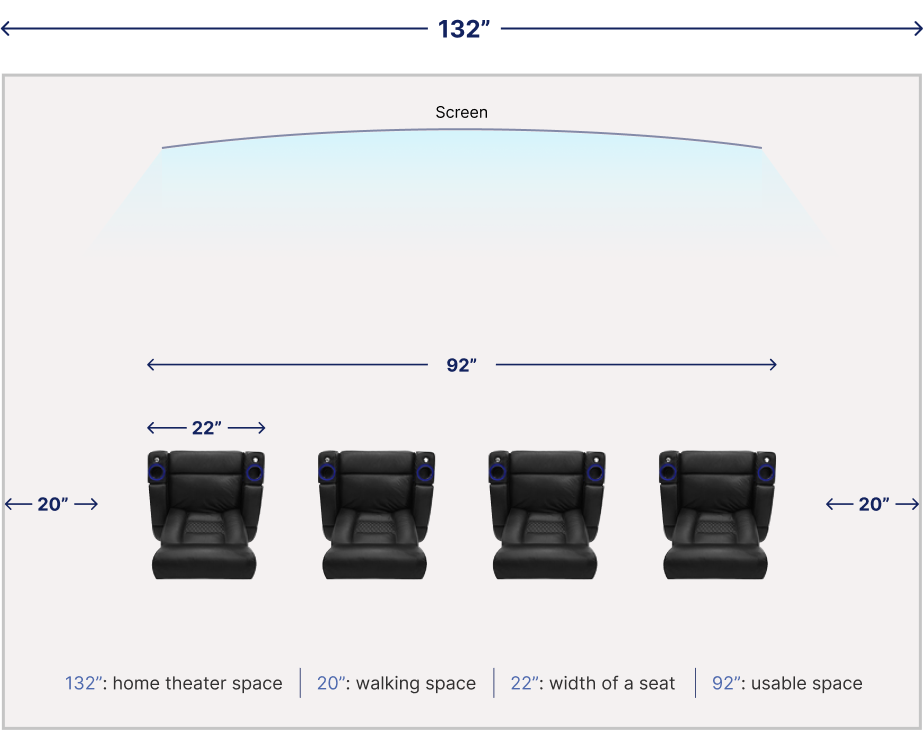
home theater space
Width of a seat
Number of Seats
And if the seats you are considering are 22 inches wide, you can divide the usable space by that chair width for how many seats will fit in each row. In this case, your home theater can accommodate 4 seats per row (132” – 20” – 20” ÷ 22” = 4).
Sound System Considerations: Speakers and Seating
In general, you don’t want your speakers to reside too close to your audience’s ears. Because cinematic sound media is best when projected, you need room for the acoustics to resonate before being processed by the listener. And while there are exact guidelines for spacing specific types of speakers, you can keep some general tips in mind when calculating your theater seating space.
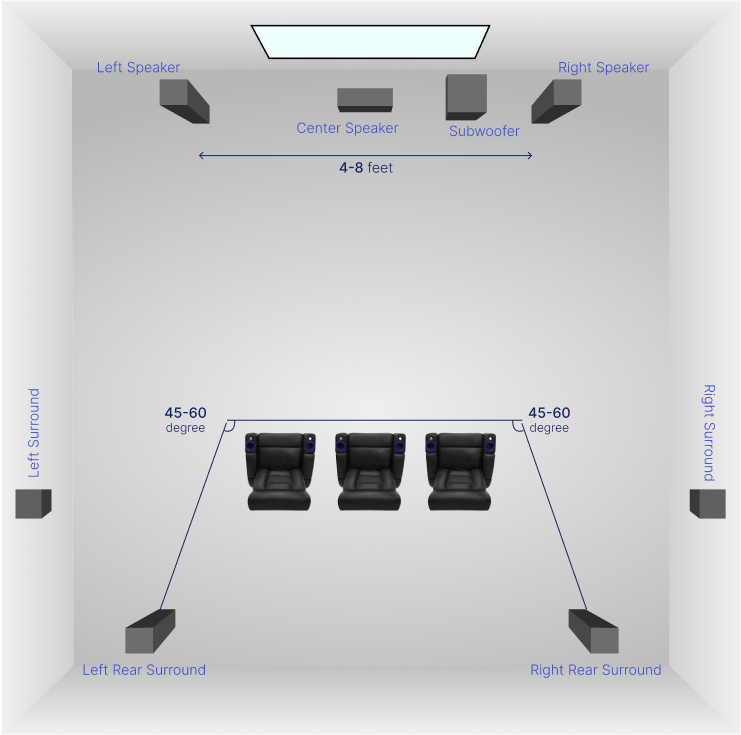
Your front speakers should be kept equidistant to the center of the TV screen, Your front speakers should be kept equidistant to the center of the TV screen, and 2 to 3 feet away from any walls and audience chairs.
Surround sound speakers should be spread out at a 45 to 60-degree angle to the closest seating, and any rear surround units should be at the ear level of the audience if you are not using risers for seating staggering and elevation. While not as tricky as some room size calculations, it’s still important to keep your speaker setup and sound systems in mind when shopping for home theater seating.
Seat to Screen Calculations
Viewing angle and distance are both essential factors in planning your seating. When you sit appropriately far from the screen, you reduce the possibility of eye strain, headaches, or muscle soreness from craning your neck or twisting your body for long periods of time, overall improving your viewing experience.
When it comes to the angle of the audience to screen,
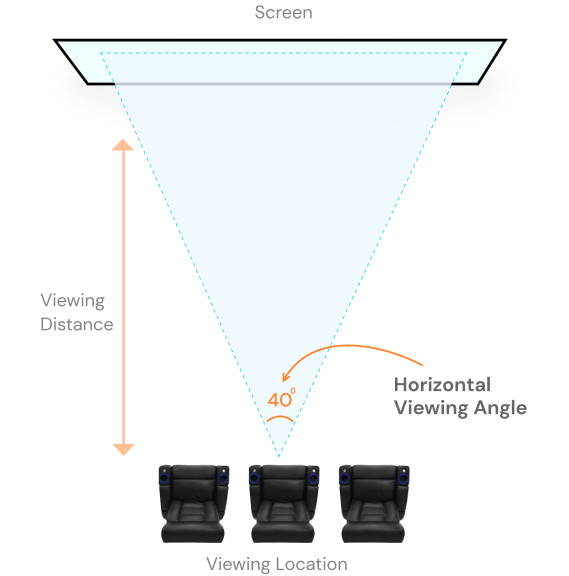
you want to keep the horizontal viewing angle to around 40 degrees, which is the typical range of comfortable head movement.
For the vertical viewing angle, don’t exceed 35 degrees between the viewer’s headrest and the screen.
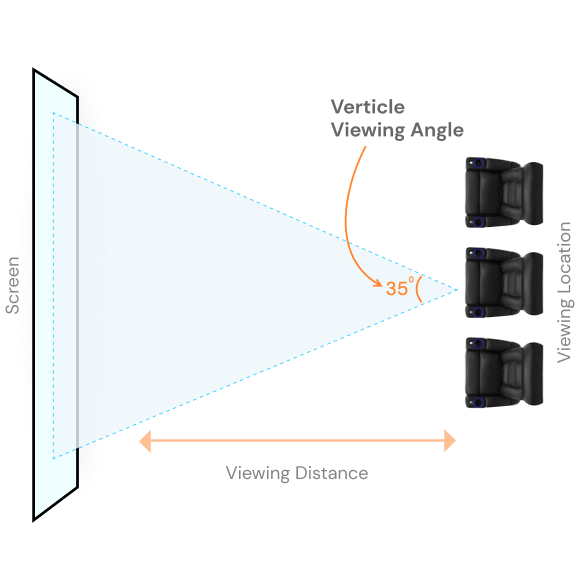
The base formula for minimum and maximum viewing distance is as follows: multiply the horizontal width of your screen it by 2 for minimum distance and multiply it by 5 for maximum distance.
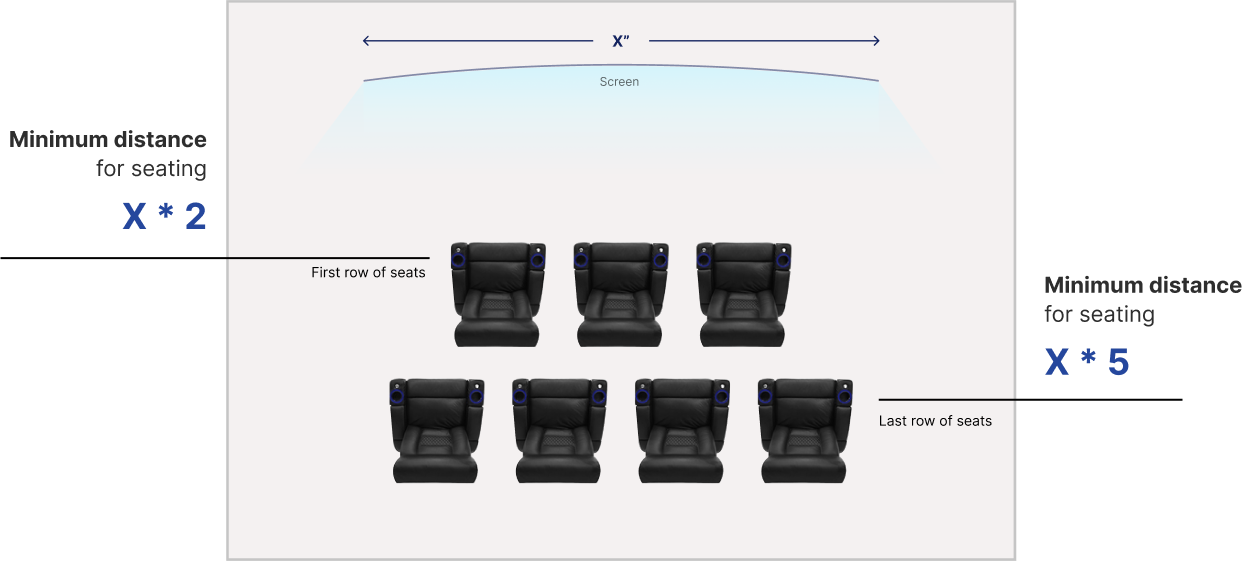
The first row of seats should be at the minimum viewing distance from the screen, and the last should not be further than the maximum viewing distance. This calculation will give you the available length measurement for your home theater seating.
If you need some assistance with the math, check out this home theater calculator for more information on the calculations, or refer to the following table for popular screen sizes and the recommended viewing distance range that your seating plan should adhere to.
| Screen Size | Recommended Range |
|---|---|
| 26” | 3.25’ – 5.5’ (1.0 m – 1.7 m) |
| 32” | 4.0’ – 6.66’ (1.2 m – 2.0 m) |
| 37” | 4.63’ – 7.71’ (1.4 m – 2.4 m) |
| 40” | 5.0’ – 8.33’ (1.5 m – 2.5 m) |
| 42” | 5.25’ – 8.75’ (1.6 m – 2.7 m) |
| 46” | 5.75’ – 9.5’ (1.7 m – 2.9 m) |
| 50” | 6.25’ – 10.5’ (1.9 m – 3.2 m) |
| 52” | 6.5’ – 10.8’ (2.0 m – 3.3 m) |
| 55” | 6.9’ – 11.5’ (2.1 m – 3.5 m) |
| 58” | 7.25 – 12.0 (2.2 m – 3.7 m) |
| 65” | 8.13’ – 13.5’ (2.5 m – 4.1 m) |
| 70” | 8.75’ – 14.75’ (2.7 m – 4.5 m) |

Types of Home Theater Chairs

Once you have determined the space that is available for seating in your home theater, it is time to explore the types of chairs you have to choose from. Because entertainment seating is so varied, there is something for everyone’s preference and home theater setup constraints. Let’s take a closer look at some of the most popular choices for seating types and how they can fit into your home theater.
Chaises
Chaises allow for optimal leg support, as they are essentially long chairs that have built-in legroom.
If you want extra comfort while
enjoying your home theater experience,
being able to sit or lie down with a chaise might be the choice for you. Because chaises typically come as part of a sofa set, they are not as easy to arrange as other types of seating, but you can customize your chaise arrangement to fit your home theater space.
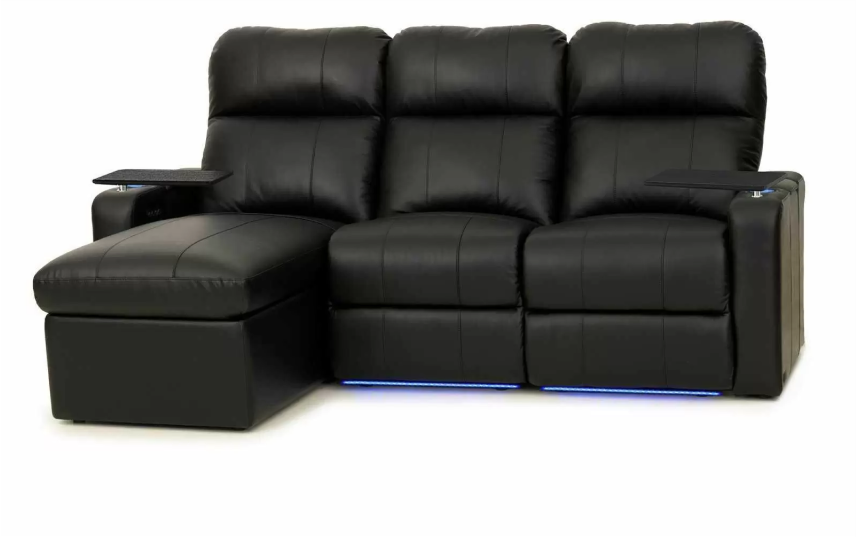
And once you have opted for a chaise setup, you can have many different row layouts—such as consecutive chaise seats, a row with two chaises bookending two non-chaise seats, or even one chaise and one non-chaise seat. The variations are up to you and dependant on your room size and how many seats go into a row.
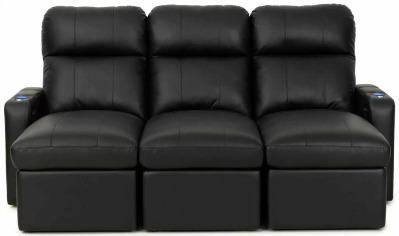
Consecutive chaise seat
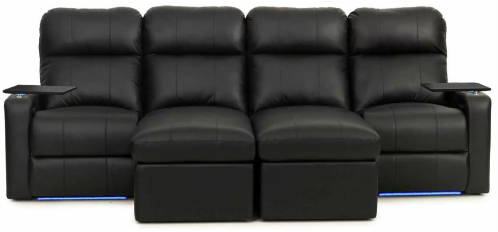
A row with two chaises bookending
two non-chaise seats
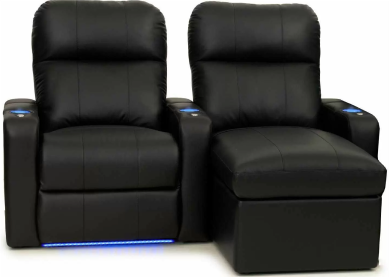
One chaise & one
non-chaise seat
Because row layouts are so very customizable with chaises, they are perfect for larger home theater audience numbers. Chaises give you a decadent, lounging feeling and are incredibly comfortable. However, do keep in mind that like recliners, these seats do take up more space.
Home Theater Sectionals
Another type of seat that comes pre-arranged together in a row, sectionals are more like sofas or chaises where you have quite a bit of room to get comfortable in.
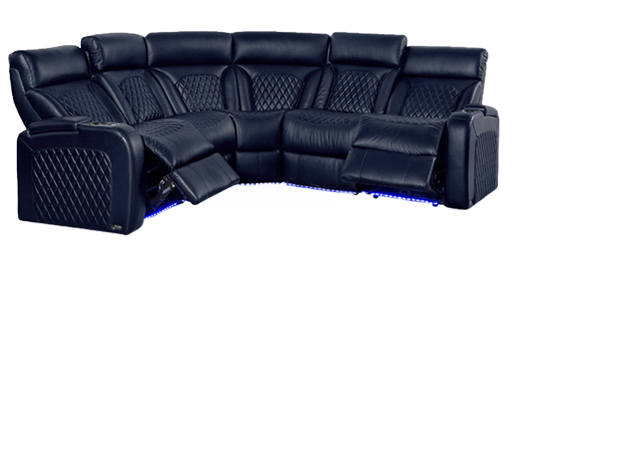
And because they are a larger seating unit, sectionals require a decent amount of seating space in your home theater room, so keep that in mind.
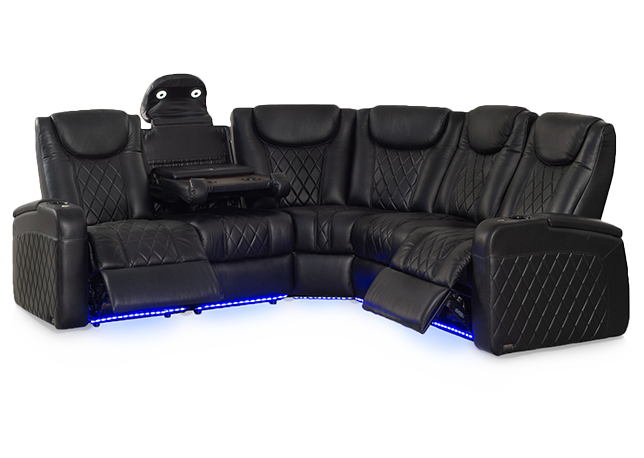
Recliners
These chairs have always been incredibly popular, since being made mainstream by La-Z-Boy. Because of their excellent lumbar and neck support, your comfort is all but guaranteed.
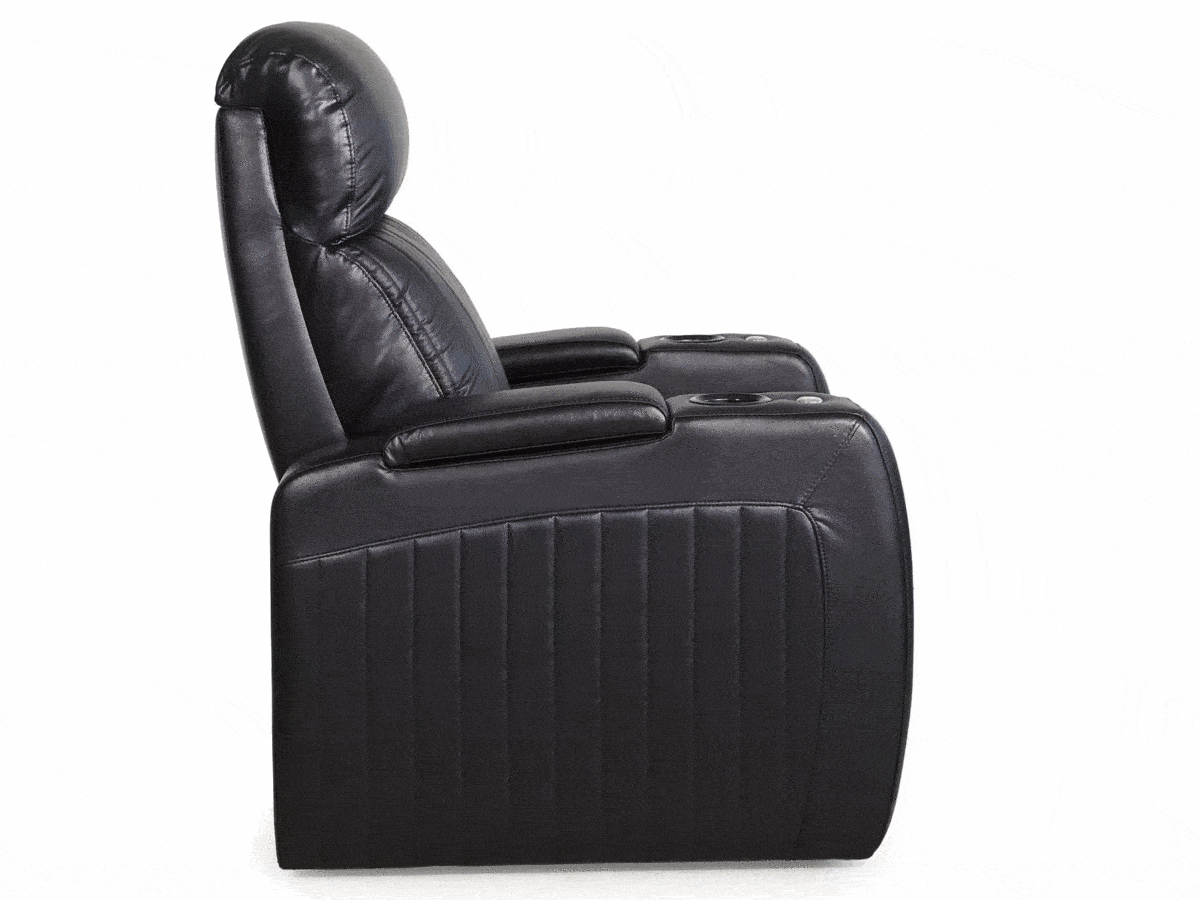
And recliners offer footrests when you use the lever or remote that makes them recline back, giving your entire body support.
Typically, recliners come in five different types:
What type you choose is very subjective—your preferences and home theater layout are essential.
One thing to keep in mind is the arrangement of recliner seats in your home theater. While a singular recliner is easy to position, using recliners for seating rows is different. Ensure that you have enough room for fully reclined seating too, as an extended recliner adds footrest length, making them somewhat more difficult to arrange in your space.
C-Shaped Media Row with Recliners
Made of four seats, this is a special pre-connected row arrangement of recliners that are in the shape of a C. Typically, cupholders for each seat are included, and either a lever or remote to initiate the reclining features.

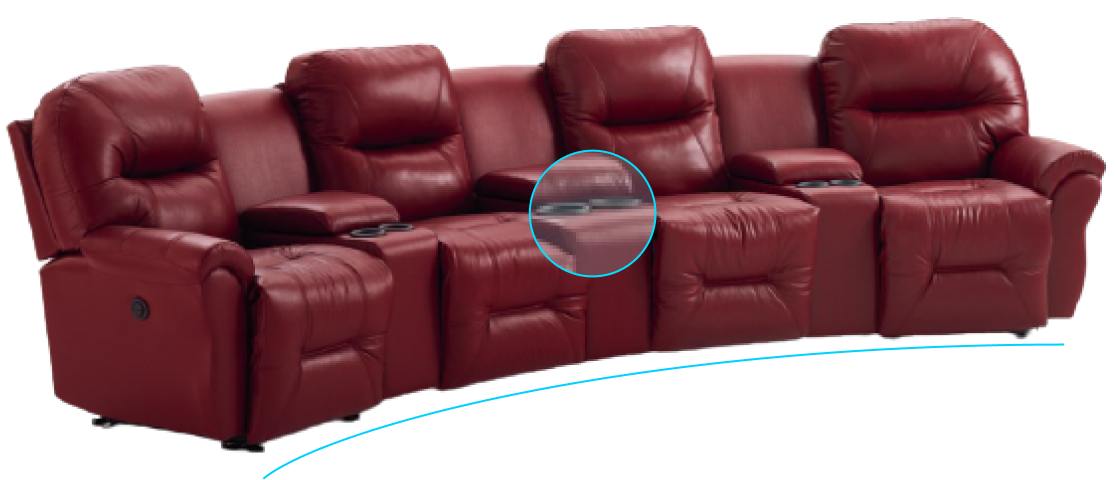
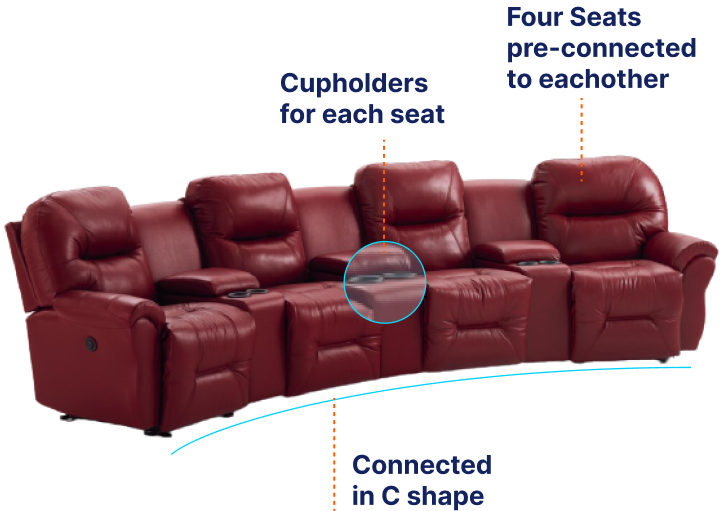
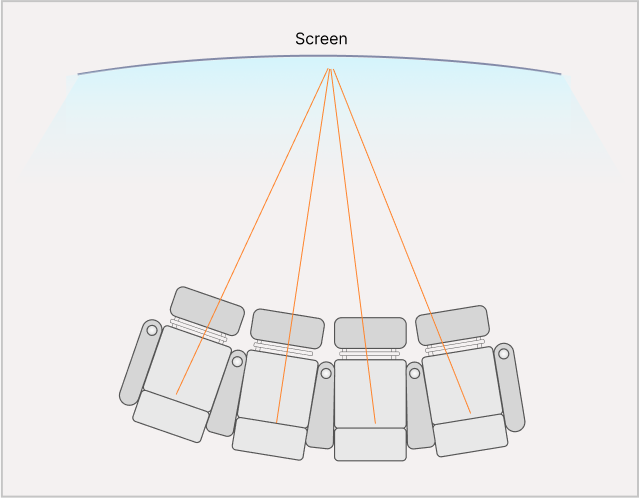
With the C shape arrangement of recliners
and because of their C arrangement, each seat will have a properly angled view of the screen, without the need for neck strain or awkward body positioning.
With the straight row arrangement of recliners
as with the straight row recliners, you will need a bit of extra space to account for the reclining extension of the footrests.
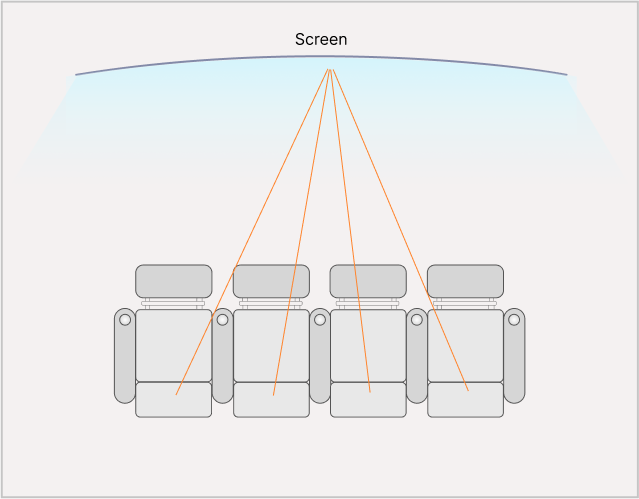
C-shaped media rows tend to be good for medium-sized home theater setups and come with the added bonus of storage room within the recliner units themselves for easy stashing.
Rockers
These are very similar to the seats you find in movie theaters and cinemas.

Rockers are able to lift and, true to their name, rock back somewhat so that you can recline and relax, although the footrest is optional.
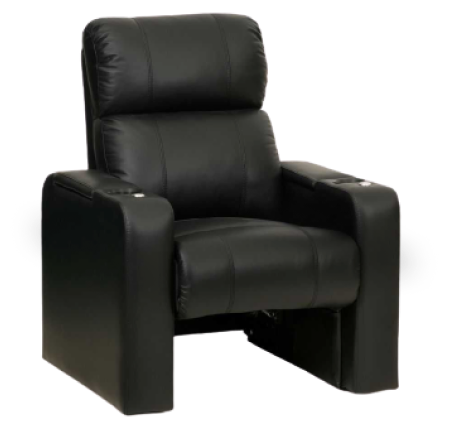
When it comes to your seating layout, rockers come separately or attached in rows, so you can easily tailor these rockers to your available seating room.
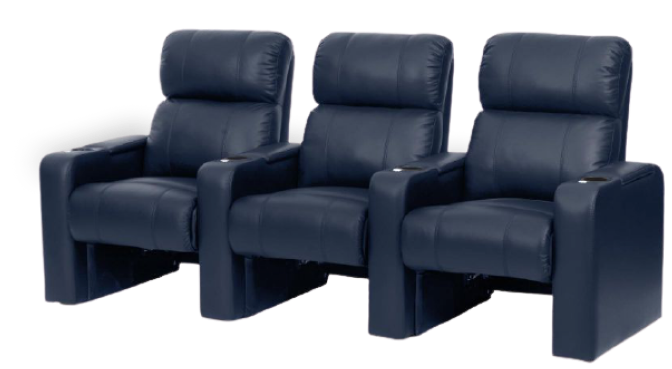
Because rockers do not extend as much as recliners, this kind of seating can be more space-efficient while still being comfortable. Their versatility and compactness make rockers perfect for both small and elaborate home theater setups.
Sofas
While not the usual selection for a home theater build, you can indeed utilize sofas as your seating. And because they come in nearly endless arrangements and seats, from doubles to 7-seaters to 13-seaters, you can easily customize the sofa layout in your home theater.

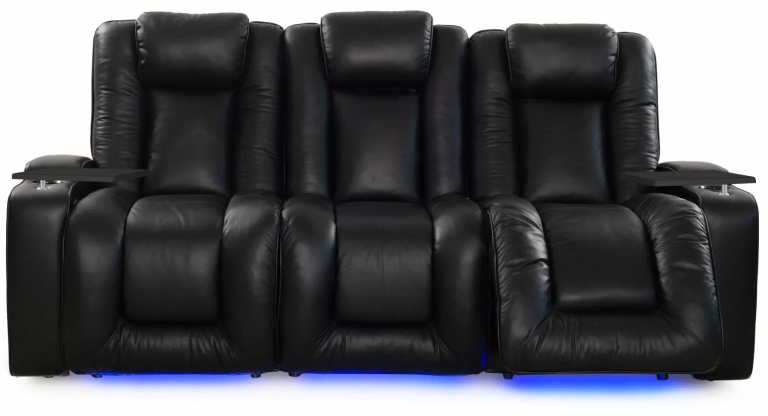
Some sofa designs also allow for rock-back and footrest extension, giving you all the comfort of a recliner in a sofa. If you want a homey feel to your home theater and have a very family-orientated audience who don’t need separate seating, a sofa arrangement can be an efficient and cost-effective option for your seating needs.
Theater Seating for Children
If you are investing in a home theater setup, and have a family, you might want to get some kid-sized seating. Theater seats for children are available in sets or as a single chair and are just as comfortable as their adult-sized counterparts.
With reclining ability, selection of materials, and even cupholders, your children can sit in style along with the rest of the audience.
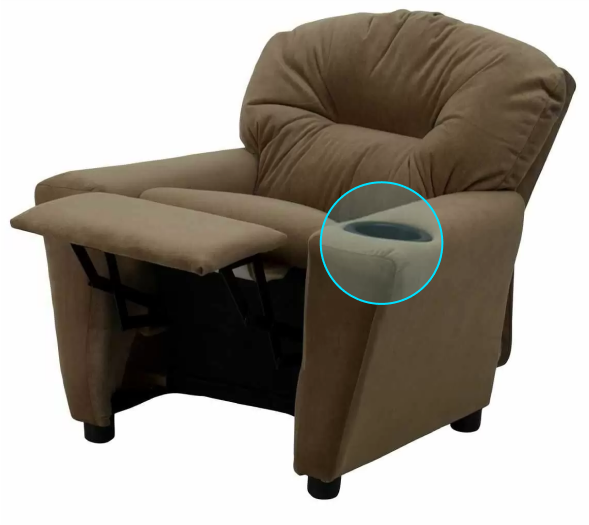

Types of Home Theater Chair Materials

Now that you have decided on how many chairs and what types are the best for your home theater setup, you can concentrate on more visual matters!
When it comes to the material that your seats are made of, your choice of fabric has to do with personal comfort preferences, cleaning considerations, and even reflection on the TV screen.
Factors that play a role in the quality of your viewing experience
Bright white seating may reflect more light onto the screen, and a bright orange material might tint the picture.
As for the material itself, leather will be more reflective than velvet or meshy materials, and a plushier fabric will not affect the reverberation of sound and impede your audio experience less. But the balance of looks and performance generally has a minimal effect on the AV quality of the seating setup.
Material for Home Theater Seating
In general, selecting a plush material is a popular choice for theater seating.
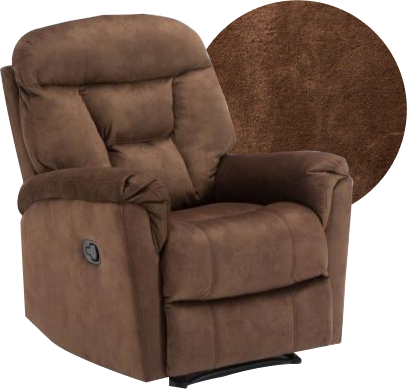
Velvety Material
With a velvety material, you get a luxurious and absorbent experience while not compromising durability.
Fabric Material
However, as it is fabric rather than leather, stain treatments will be required over time in high-use areas of seating. Stain-guarding and fire barrier treatments are available for your seating if you want an extra layer of protection.
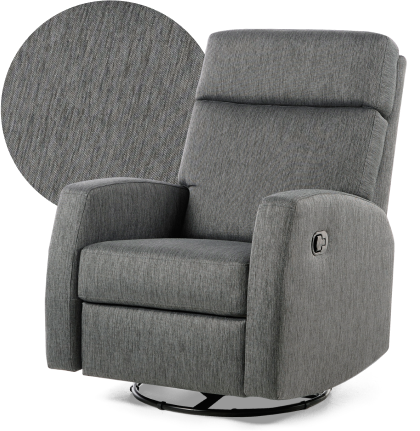
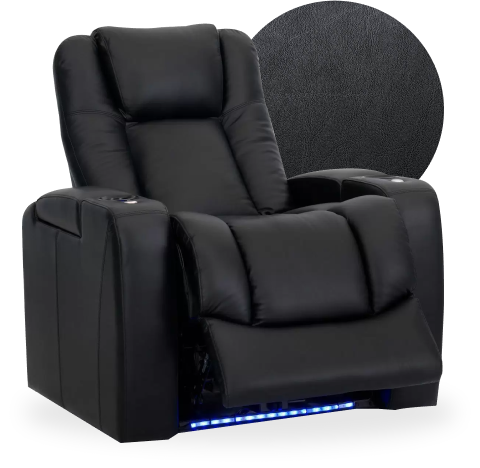
Leather Material
Leather is extremely durable and has several coloring options and has a very suave and modern look.
Because it is an easily cleanable surface, leather is less susceptible to stains, dirt, and other marring. If something smudges or stains your leather seating, a simple wipe will clean it up. However, because leather is a natural material, it can stretch over time and use, and can be more expensive than fabric options. You can select between top grain leather, bonded leather, or leather gel.
Other options for your seating materials can include:

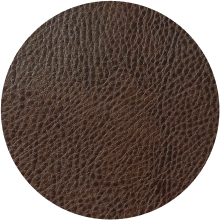





What Brand to Buy?
Because shopping online for your seating needs opens up a world full of options, you can browse the full range of colors, sizes, and styles. But what about the brand? Your home theater seating concerns are primarily governed by room size and style of chair, but the brand can also be a consideration depending on budget and preference.
Some of the top brands for your home theater seating include:

Types of Home Theater Seating Feature

Your home theater seating can be accessorized more than you can imagine. Whatever features you might want for your home theater setup, they are likely available for you to add to your seating.
Gadgets and accessories are handy for heightening your entire home theater viewing experience and having everything you might need right next to you, be it snacks or drinks, is a convenient addition.
Accessories Docking
If you want all your things at your fingertips, you can have accessory docks attached to your seating.
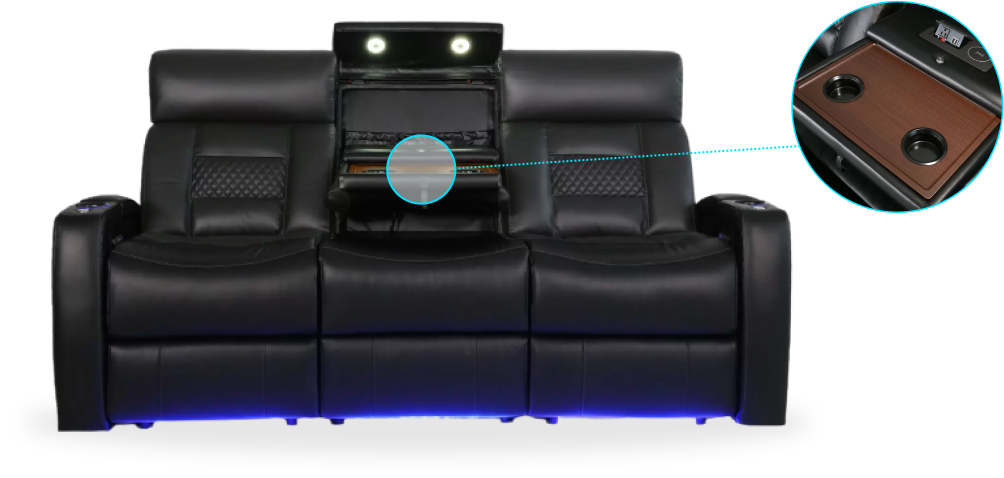
Swivel trays can hold your popcorn, tablet holders contain your devices, and the entire thing can fit back into the armrest of the chair. You can also get your docks in whatever size necessary, depending on your needs.
Arm Storage
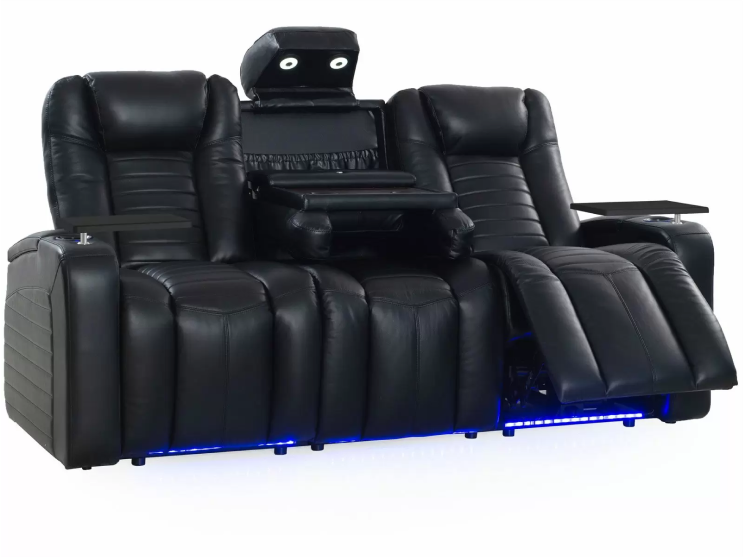
Seating can come with storage options within the armrest for convenience.
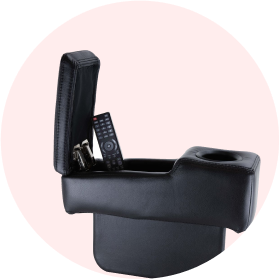
You can store your essential cords, adaptors, remotes, and even snacks or candy inside your seating units themselves, saving you some space in your home theater.
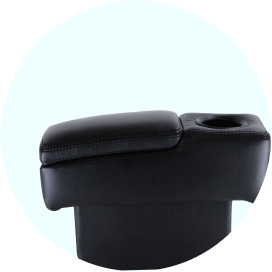
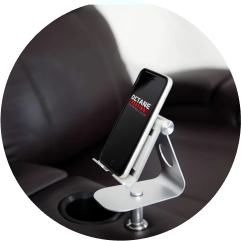

Cup Holders
Having your drink settled next to you is a great way to free up your hands when watching a film. Most seats do come with cupholders that are within the armrest or are attached to it.
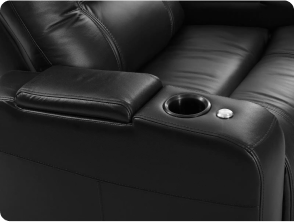
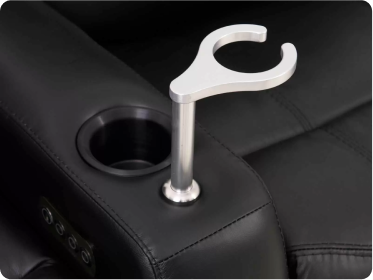

Some models of pre-arranged seating rows come with more than one cup holder, but if not, you can add a cup holder accessory for your convenience.
Footrest
It might seem like an obvious addition to your home theater seating setup, but footrests are a definite plus.
Even if your seating type does not include a footrest, you can add one on. Or invest in an ottoman to support your feet during movie nights.
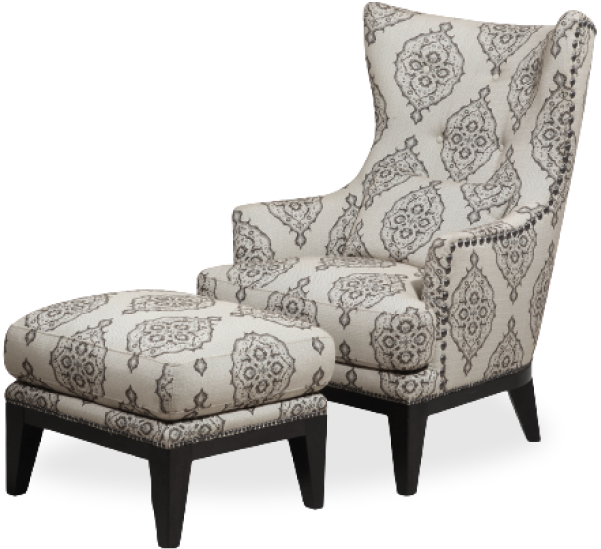
Footrests for your seating can be motorized or come as a chaise-style footrest.
Heat and Massage
If you are looking for the ultimate relaxation experience in your home theater, investing in seating with heat and massage capabilities is the way to go. Settle in, turn on the system, and feel the stresses of the day melt away.
LED Lighting
Not only handy for maneuvering around a darkened home theater room, LED lighting also creates ambience while not affecting screen image projection.
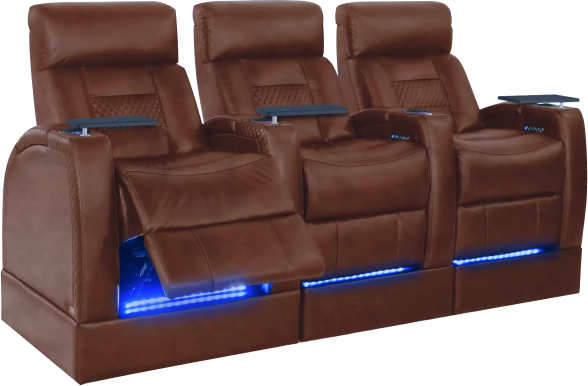
You can easily find your drink, snack, or device with cupholder and tray lighting, and under-footrest LEDs give your home theater’s aisleways a glow that is convenient for anyone moving around.
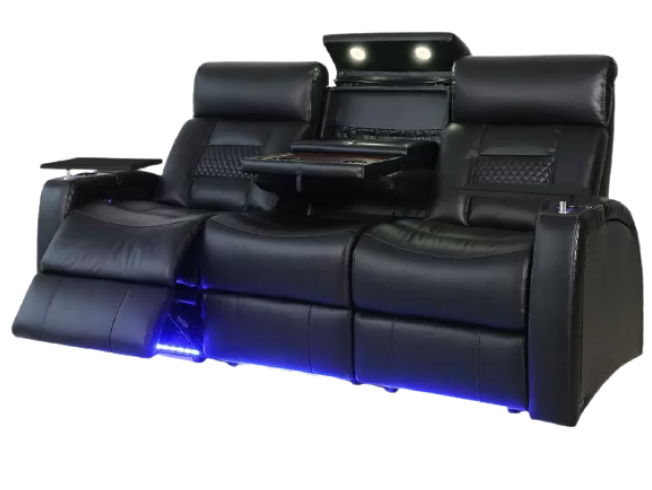
Lumbar Support

When it comes to seating, lumbar support is key. Your back, neck, and spine will thank you after giving it the proper support in your chair, and ergonomic theater seats offer excellent lumbar support.
Typically, they have padded coil springs to ensure your comfort and support for your spine.
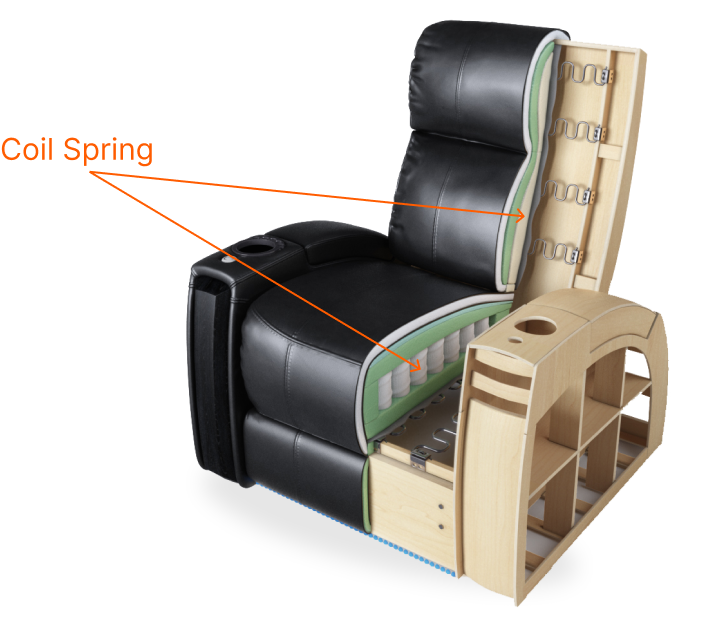
Memory Foam

For optimal comfort, memory foam makes sure your seat takes the shape of your body, providing a relaxing seating environment that makes your viewing experience even better. Let your limbs sink into the breathable softness, and relax during your viewing.
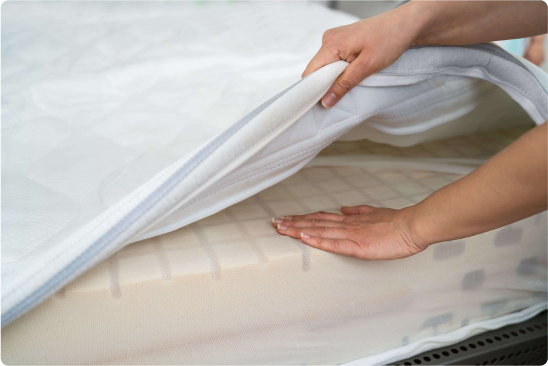
Pillows
Enhance your comfort by adding some individual pillows to your seating setup. Head and neck pillows offer support, and lumbar pillows mold to your lower back to alleviate your muscles and spine.
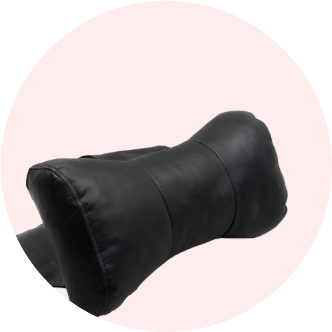
Head and neck pillows
Head and neck pillows offer support
Lumbar pillows
Lumbar pillows mold to your lower back to alleviate your muscles and spine.

You can even use such pillows in combination with office chairs when you are not watching a film, taking advantage of their support and convenience outside the home theater.
Power Headrest
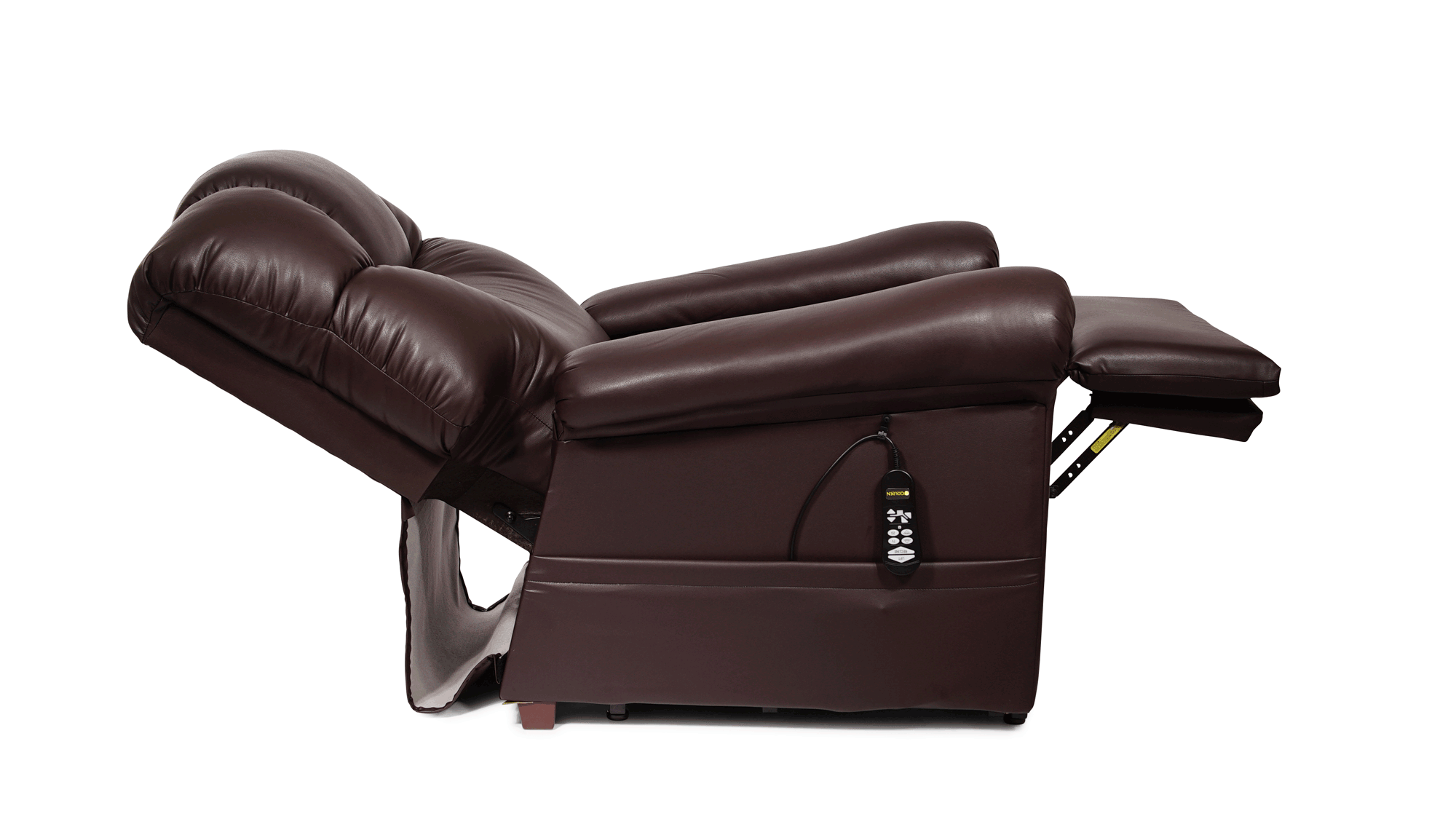
If your seat unit does not come with a power headrest, you can add one on yourself. Power headrests offer comfortability and support and are completely customizable—adjust your neck angle with the controls and ensure your viewing angle is ideal. These are especially useful for audiences who watch long films and need consistent support for their neck position.
Reclining Mechanisms
Your recliner will either use a lever or a motorized reclining mechanism to extend out and back, providing extra comfort for the occupant.
Most home theater seats recline back to a 50-degree angle, giving you some more legroom and head support.
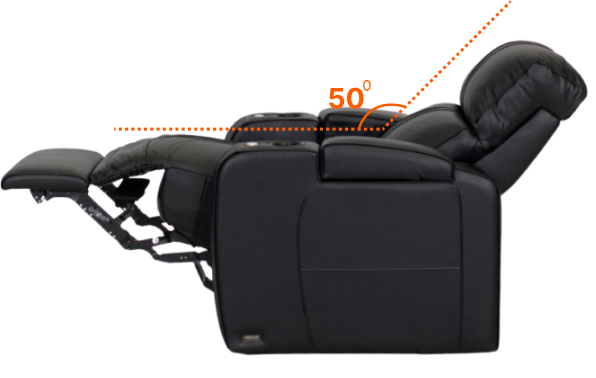
Because home theater seats provide great lumbar and neck support, you can rest assured that your spine and head are safely positioned even when reclined.
Seating Type
This actually refers to the specific cushion part of each seating unit. Because there are different options for the seat type, you can choose the one that best suits your needs.
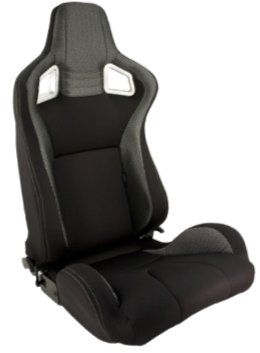
Bucket Style Seat
This style lets the occupant nestle into the scoop of the seat, with full, curved back support.
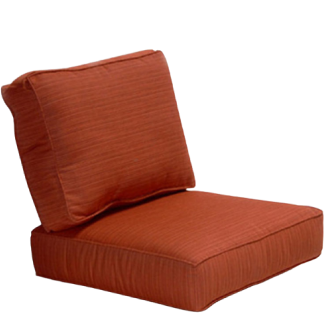
Contour Style Seat
By removing pressure on knees and hipbones, the viewer can comfortably sit in this sloped seat for long stretches without soreness.
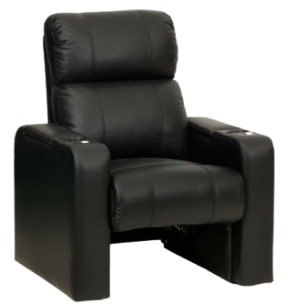
Standard Seat Pitch
A basic seating cushion found in most movie theaters, the occupant sits upright and securely.
Tray Tables
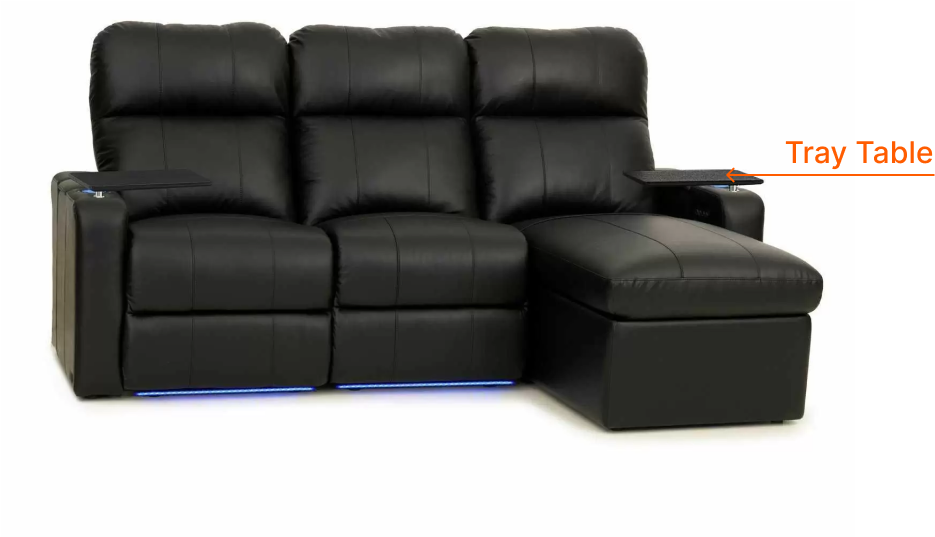
Never worry about your snacks, tablet, or remote control again with swivel trays that attach to your seating. These trays typically come in a variety of finishes and materials, including wood, glass, and aluminum.
Additionally, you can get attachments that are designed to support
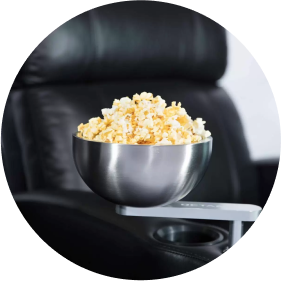
Popcorn or Snack
bowls

Wine glass holders

Cigar or Cigarette
holders
USB Charging Port
Charge all your devices as you enjoy a film in your home theater. With a built-in USB charging port, you can ensure your phone or tablet never has a dead battery mid-way through a movie night. In today’s age of technology, many people find this to be very useful.

Home Theater Seating Delivery

Once you have selected your seats and accessories, it is time to bring everything home.
Most home theater seating will ship to your door within a few weeks, but keep possible shipping delays in mind. And because seating units are typically very heavy freight, your courier may take a bit of time to get to you.
If you are curious about the available delivery options and what each entails, you can check out this guide to shipping and delivery. And at the end of the day, ordering your seating online is the fastest and most convenient way to purchase home theater chairs, and installation is easy once your units have been delivered to your house.


Buying Home Theater Seating Online

If you are investing in a home theater, purchasing the best seating possible is a crucial part of enjoying your movie nights.
And when you shop for your seating online, you remove the hassle of going to a store and waiting for service.
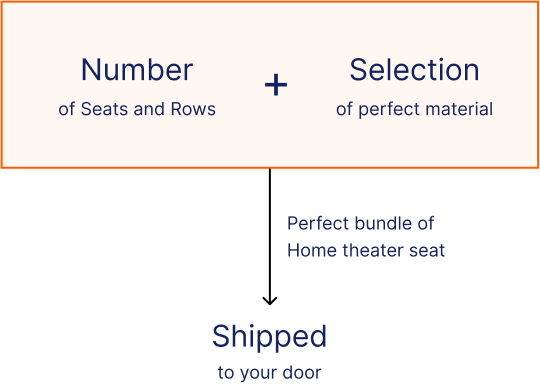
Add some seating features like swivel trays, device holders, USB charging ports, LED lighting, and many more to enhance your home theater experience even more, and then sit back and relax in your new seating arrangement.
- What factors should I consider when building a home theater?
- How big should I build my home theater?
- How much room do I need for a home theater?
- How should I space my speakers in my home theater?
- What are all the types of home theater seats?
- What are chaise sofas?
- What are the different types of recliners?
- What are rocker seats
- What are all the theater seat material options?
- What are the best home theater brands?
- What styles of seat cushioning are there?
- What to consider when buying a home theater online?
- Best Loveseat
- Acoustic Innovations Theater Seating
- Loveseat Or Sofa
- Best Theater Chairs Recliners
- Sectionals
- Reclining Leather Sofa Sets
- Best Leather Recliner Sofa
- Three Piece Home Theater Chairs
- Home Movie Theater Room Chairs
- Classy Recliner
- Movie Theatre Seats For Basement
- 2 Seater Media Recliner Sofa
- Best Leather Sofa Brands
- Home Theater Loveseat
- 3 Piece Leather Furniture Set
- Octane Table
- Couch Usb
- Best Buy Theater Chairs
- Octane Riser
- Custom Home Theater Seating
- Black Fabric Sofa
- Motion Loveseat With Console
- Bass Shaker
- Sofa For Back Pain
- Ashley Furniture Theater Seating
- Acoustic Innovations
- 2 Seater Recliner With Console
- Chair With Cup Holder
- Diamond Pattern Couch
- Multimedia Seating Middle Folds Down
- Number One Rated Recliner
- Theater Basement Ideas
- Home Theater Loungers
- Seating For Man Cave
- Tv Watching Chairs
- Wire Home Theater System
- Microfiber Sofa And Loveseat
- Sleek Theater Seating
- Home Audio Crossover
- Large Lounge Sofa
- 4 Seater Sectional With Chaise
- Cuddle Chair Sale
- Cloth Couch Set
- Dual Power Seats
- Black Reclining Sofa





